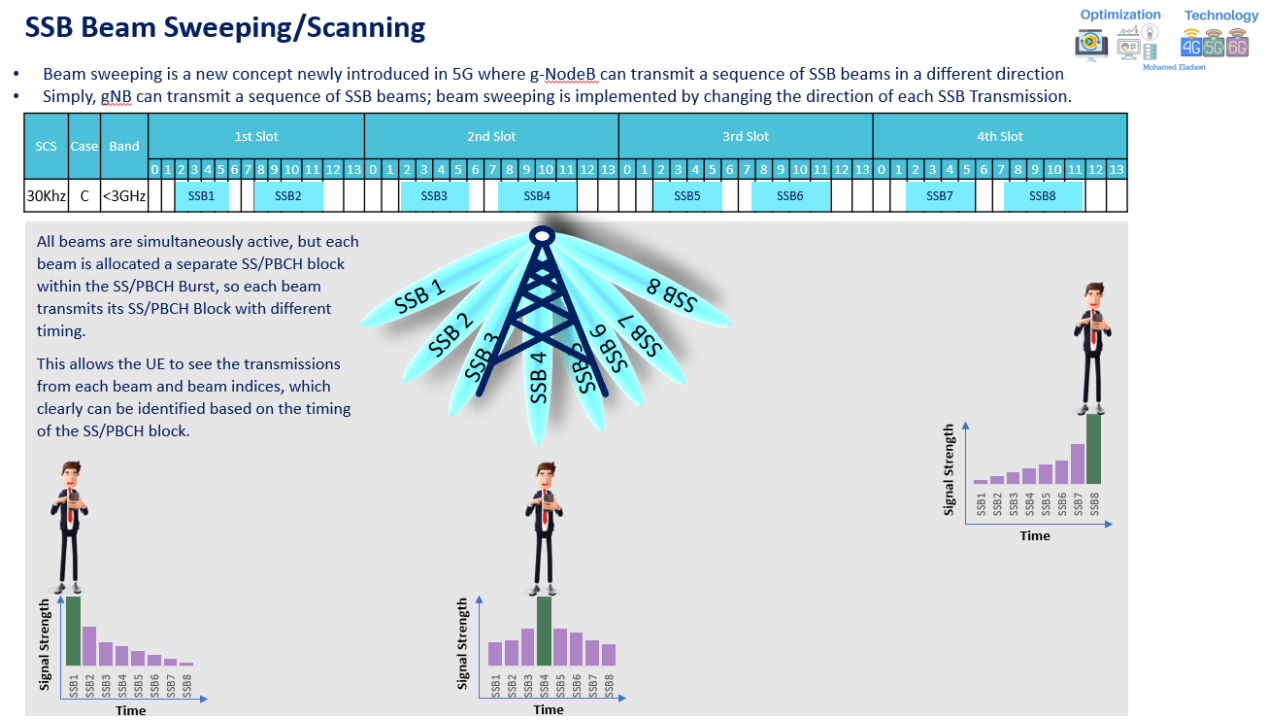
Illustration about 5G SSB Beam Sweeping, SSB Freq/time domain allocation methods, SSB Overhead Calculation, and SSB Related Parameters
SSB Beam Sweeping
Beam sweeping is a new concept newly introduced in 5G where g-NodeB can transmit a sequence of SSB beams in a different direction.
Simply, gNB can transmit a sequence of SSB beams; beam sweeping is implemented by changing the direction of each SSB Transmission.
All beams are simultaneously active, but each beam is allocated a separate SS/PBCH block within the SS/PBCH Burst, so each beam transmits its SS/PBCH Block with different timing.
This allows the UE to see the transmissions from each beam and beam indices, which clearly can be identified based on the timing of the SS/PBCH block.
The UE measures and reports all the transmitted SSB to the g-NB, and the best beam will be selected by the g-NB based on the RSRP.


What are the main advantages and disadvantages of Beam SSB Beam Sweeping?
In general, transmitting SSB beams in a different direction is part of beamforming, which is expected to offer a gain in coverage and interference (SINR).
However, More beams will introduce an extra Overhead for the resources occupied by SSB and for the resources occupied by CORESET(SIB1), as each SSB Beam will be associated with SIB1.


Frequency domain resource allocation
What exactly does it mean by frequency resource allocation in SSB?
- Well, after the UE blindly detects SSB during the initial access, still frequency resource location is not known to the UE; accordingly, additional information will be delivered to the UE to be able to find and specify SS/PBCH block frequency domain position within the channel bandwidth.
- In general, there are two methods to identify the frequency domain position of the UE during 5G Standalone and Non-Standalone

Where:
- OffsettoPointA: Defines a resource Block offset between Common Resource Block 0 and Common Resource Block which overlaps with the start of the SSB
- kSSB: Defines a subcarrier offset from subcarrier 0 of the Common resource Block identified by offsettoPointA to the subcarrier 0 of SSB
- AbsolutefrequencyPointA : Absolute frequency position of the reference resource block (Common Resource Block 0). Its lowest subcarrier is also known as Point A, and it represents the frequency-location of Point A expressed as in ARFCN
- AbsoluteFrequencySSB: identifies the position of resource element subcarrier 0 of a resource block 10 of the SS block (expressed as in ARFCN)
Frequency offset Approach/Method 1
After UE completes the band scan and identifies the SSB frequency domain, the UE Still does not know the position of channel bandwidth relative to SSB.
The UE will decode MIB/SIB1 to retrieve a combination of Kssb and OffsetoPointA information to locate the Channel Bandwidth position.

ARFCN Approach/Method 2
The Frequency domain of an SS/PBCH Block within the channel bandwidth can be specified using a pair of absolute frequencies delivered in the dedicated signaling “RRC Reconfiguration message.

Time domain resource allocation
According to 3GPP 38213-h30, the first symbol indexes for candidate SS/PBCH blocks are determined according to the SCS of SSB blocks, Frequency Band, and Duplex mode.

The number of SSB beams supported in a cell will be indicated through a parameter called SSB-PositionInBurst.

The Below figure will illustrate how the SSB resources will be allocated in the time domain for Case A to C

- Five-time domain positions (Case A to Case E) are specified according to the protocol
- TDD 2.4 Band is currently using Case C
- All SSBs will be transmitted in total 5ms, usually in the first half of the frame
SSB Main Parameters
3GPP TS 38.213 specified 3 main parameters that can be tuned for SSBs and are being transmitted through SIB1 or Dedicated Signaling(RRC Reconfiguration message)


Example for SSB broadcasting
1.SSB Periodicity = 20ms
2.SSB-PositionInBurt = 1111000 (4SSBs are active)

SSB Overhead Calculation
The Overhead consumed by SSB will vary with different Bandwidths and SCS configurations. The following are the main factors involved in SSB overhead calculation.
1.The sum of the Number of PSS, SSS, and PBCH Resource elements (Fixed Values)
2.Number of SSBs in a frame(Changes based on configuration)
3.Total Resource blocks (Variables), Total number of slots per frame(Variables)
4.Total Number of symbols(Fixed Values)
In more simple words, you need to calculate the total number of resource elements being used by SSBs in a frame and then divide it by the complete available resources in the frame; let’s have a look at the formula suggested for calculating SSB overhead%

The below video simulate all the above contents
Materials uploaded to the below blog
Functional Safety, EMC, EMF and EM Simulations
3moVery great explained, Mohamed... How many us/ms (10-20ms?) will take one block by sweeping and will be the beamforming in horizontal and vertica positions? With 5G, is the frequency spectrum comparable to spread spectrum or ultra-wideband modulation in terms of energy distribution? What is important for measure the correct field strength related to CNIRP & EMF EU Directive?
Assistant Professor, NIT Raipur
7moThat is really nice description regarding SSB sweeping. Much appreciated 🙏
Sr.Test Engineer || UI and Chipset Testing || Log Analysis || Modem Testing || 5G - SA , NSA and LTE Protocol Testing ||
11moThanks ..very useful content
ORAN | 5G NR | LTE Protocol testing
11moVey Nice thanks for sharing.